0676 Here is a picture of the underlying conundrum.
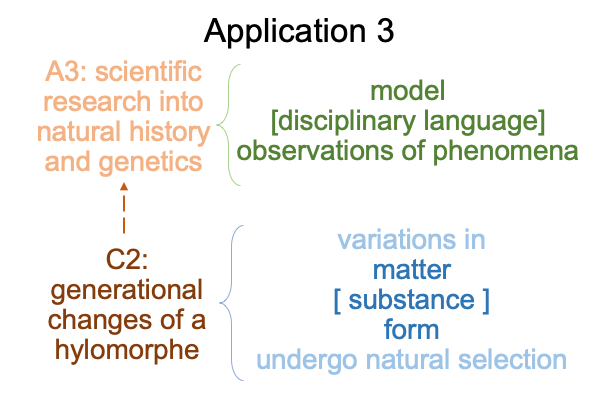
Which scientific field is supposed to recognize Tabaczek’s portrayal of evolutionary transitions as a sequence of generational changes of a hylomorphic structures, such as matter [contiguity] form?
Genetics? Natural history?
How are these sciences supposed to do that?
0677 Okay, with this in mind, let me try the third application again.
Genetics and natural history, the two foundations for the evolutionary sciences (A1), project their models onto the noumena in the theologymirror (D2), along with their conviction that phenomena cannot objectify their noumenon.
A noumenon corresponds to philosophical species (natural kinds, biblical kinds and so on). These noumena also correspond to individuals. The thing itself corresponds to a substance. Aristotle’s tradition also calls individual things and creatures, “substances”, and recognizes them as hylomorphes of matter and form.
Since Aristotle’s hylomorphe exemplifies Peirce’s category of secondness, Mah commissions the term, “substance”, to label the contiguity between matter and form. This technical use raises a philosophical question about the character of the contiguity that stands at the heart of Peirce’s secondness. On one hand, the contiguity is not one of two real elements of secondness. On the other hand, the contiguity is also neither firstness nor thirdness.
0678 The thing itself is a hylomorphe, in the same way that a noumenon is its phenomena.
So the agent of theology (B3) can substitute hylomorphic structures for phenomena projected into the theologymirror(D2)).
Now, a noumenon can be objectified as a couple of hylomorphic structures.
0679 Plus, the substitution of a hylomorphe for phenomena (B) keys into Tabaczek’s use of primary matter (roughly corresponding to “presence”) and substantial form (roughly corresponding to “shape”). The author discusses the phenomena of living things in terms of matter [substance] form as well as dispositions [properties] powers (as noted in points 0030-0051 and 0663-0666).
Here is a picture of the reconstruction of the image in theologymirror (D2) by theologyagent (B3).
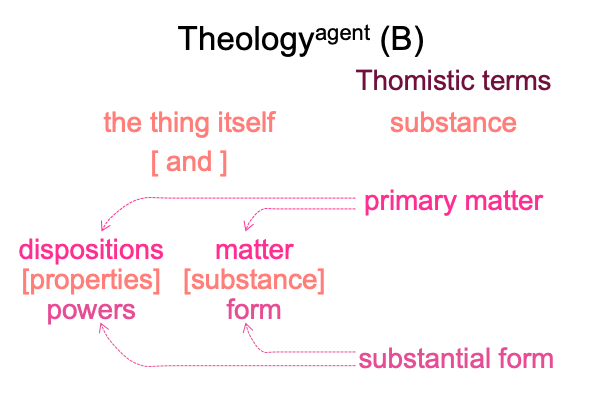
0680 Now, I return to how the theologyagent (B3) casts his own image into sciencemirror (C4).
Here is one casting.
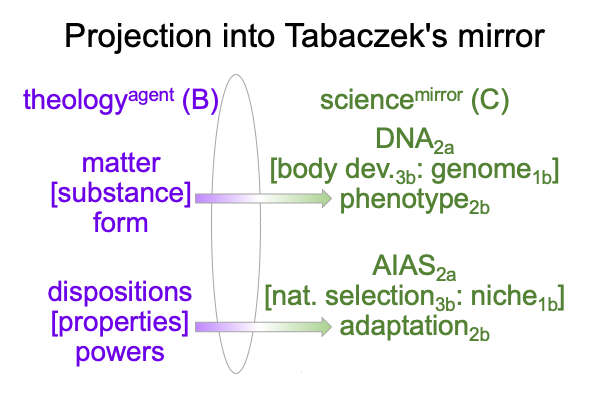
0681 Two hylomorphes relevant to theology (B1) are imaged in the mirror of science (C2) as two hylomorphes that are easy for a scienceagent (A3) to recognize.
The reflection is not perfect, because matter [substance] form associates to phenotype2b and disposition [property] powerassociates to adaptation2a.
Nevertheless, the projection is a good start.
0682 Why are the two hylomorphes (C2) easy to recognize by an agent of science (A3)?
Recalling an earlier discussion (points 0551-0570), the hylomorphes express a two-level interscope as an single actuality. The two real elements correspond to content-level and situation-level actualities. The contiguity corresponds to the situation-level normal context and potential.
0683 Here is a picture of the two-level interscope for the discipline of natural history.
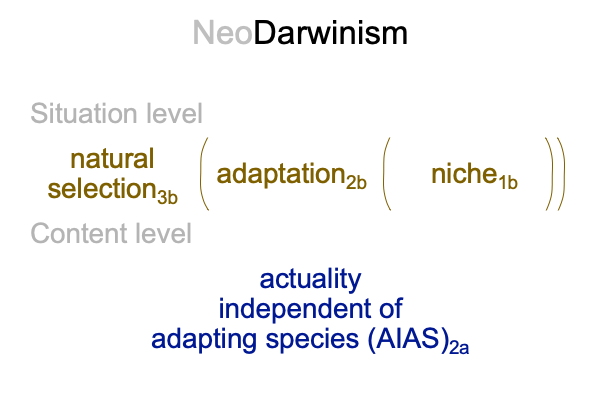
How does the discipline of natural history work?
Natural historians study the way that a niche1b, defined as the potential1b of an actuality independent of the adapting species (AIAS)2a, inspires an adaptation2b in the normal context of natural selection3b.
0684 Here is a picture for the discipline of genetics.
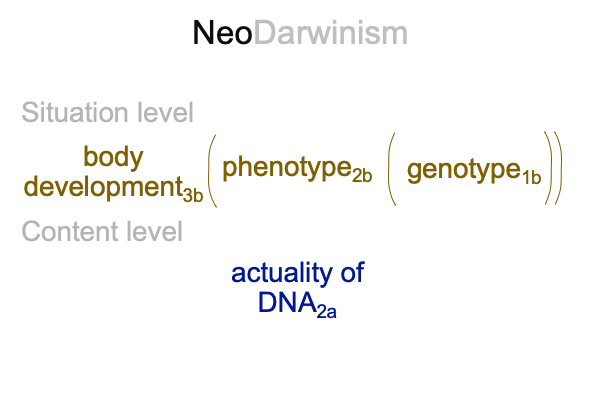
How does the discipline of genetics work?
Geneticists study the way the genome1b, defined as the potential1b of DNA2a, constitutes a phenotype2b in the normal context of body development3b.
0685 I now understand how two hylomorphes in the mirror of science (C) arise from two-level interscopes for two different evolutionary sciences.
The hylomorphes that appear in mirror of science (C2) should be recognized by agents of science (A3).
Yes, Tabaczek’s argument starts to make sense in terms of Tabaczek’s mirror.
Tabaczek asks the question, “How do Aristotelian-Thomist perspectives (B1) reflect in the mirror of science (C2)? “
